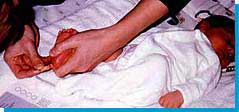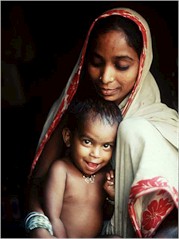|
In India, forty seven per cent of children under three years of age are malnourished, the proportion of low birth weight babies remains high, and some 50 per cent of women are anaemic.Only 50 per cent of all households are currently using adequately iodized salt. Both sustainability and quality of water supply are under threat.
In India, Iodine Deficiency disorders are prevalent in certain endemic regions of the country such as norhtern Uttar Pradesh, Bihar etc. Lack of maternal nutrition monitoring, and unawareness of the possibility of correctable metabolic disorders at birth, has resulted in developemental abnormalities in babies. This can lead to levels of mental retardation, cretinism, and in some cases even deafness. For an interesting article on thyroid and deafness , see THIS .
Checking for thyroid problems at birth is not a mandatory check in India. See this study . Our emphasis has always been on the immunization vaccines etc. In all developed countries this test is mandatory before the mother goes home after delivery.
Earlier, maybe there was no concept of "going home" after delivery. For most folks in villages, the delivery took place at home, in the presence of eperienced midwives or "dais". Check out this article Today, to a large extent, be it due to migration to urban areas etc, awareness of medical facilities has increased. In rural areas like in Gadchiroli in Maharashtra, a world class project run by Drs Bang, has succeded in combining the social acceptibility of "dais" and imparting of adequate public health modern training to these dais, so that health monitoring of the neonate and the mother is primarily done by these dais, who advise if a situation arises where a doctors intervention etc is required. The key is "awareness". For an article on "health visits to newborn homes", check THIS out .
|
 Newborn screening is basically the practice of testing every newborn for certain harmful or potentially fatal disorders that are not apparent otherwise at birth. Many of these are metabolic disorders, often called as inborn errors of metabolism, which interfere with the body's use of nutrients to maintain healthy tissues and produce energy. Other disorders that may be detected through screening include problems with hormones, vitamin levels or the blood. In general, metabolic and other inherited disorders can hinder an infant's normal physical and mental development in a variety of ways. Besides, the parents can pass along the gene for a certain disorder without even knowing that they are the carriers.
Newborn screening is basically the practice of testing every newborn for certain harmful or potentially fatal disorders that are not apparent otherwise at birth. Many of these are metabolic disorders, often called as inborn errors of metabolism, which interfere with the body's use of nutrients to maintain healthy tissues and produce energy. Other disorders that may be detected through screening include problems with hormones, vitamin levels or the blood. In general, metabolic and other inherited disorders can hinder an infant's normal physical and mental development in a variety of ways. Besides, the parents can pass along the gene for a certain disorder without even knowing that they are the carriers. Iodine deficiency in the mother can significantly influence foetal outcome, leading to abortions, stillbirths, and detrimental effects on the development of the brain. A major effect of foetal iodine deficiency is the problem of endemic cretinism. Endemic cretinism results when prevalence rate of goitre is high and urine iodine excretion is less . The early effects of iodine deficiency in the foetus are probably a result of reduced maternal T4 transfer before the onset of foetal thyroid function. Two clinical presentations of endemic cretinism are neurological cretinism and myxedematous cretinism. Neurological cretinism is characterized by mental deficiency, spastic diplegia and deaf mutism. This occurs because of hypothyroidism being confined to the in-utero or neonatal stages of life. Myxedematous cretinism is associated with severe hypothyroidism and dwarfism and occurs because of continuing hypothyroidism through all phases of life.
One of the ways we can tackle this is to initiate compulsory neonatal thyroid testing. Typically, the TSH of a baby stabilises by the fifth day after birth. Until then , any blood value reading would be unreliable. A tiny prick is made in the baby's heel, and the drops of blood are taken on a blotting paper. This technique is enough for a trained person to measure the thyroid values for the baby. Cord blood from the placenta is also sometimes used for this purpose, though the technique for measuring the required thyroid parameters through this method may be different.
Should it appear that the neonate is thyroid deficient , it is possible to intitate treatment of the order of 12 microgms/kg/day of thyroxine, under expert medical guidance. Very many times, timely detection and treatment has made the difference between a lifetime of battling mental retardation/low IQ situations, and a reasonably able, happy childhood.
Remember, the newborns brain is about one-third the adult size, and if iodine deficiency and some kind of thyroid failure continues, then the ere maybe future irreversible brain damage.
|
And finally , its the question of cost again. THYROID TESTS ARE EXPENSIVE. Thats the reality today. It need not be so.
We have the knowledge, we can master the technology. At one time doing blood sugar tests was considered a luxury and an expensive thing. Then companies came up with home blood sugar measuring machines. These are being actively marketed today, as diabetes has become a "status" disease.
When we will understand, that by ignoring a neonates metabolic problems, we are playing with and denying a possible hypothyroid child a decent , happy controlled childhood, where he can manage his own deficiency as he grows up. The government has crores to install statues , but when it comes to funding a project to design techniques and alogorhytms for cheaper thyroid testing, money is scarce.
Majority of todays , say, diabetics , are in their middle ages; they've achieved more or less whatever they could, in their lives, and families. Yet, they present an attractive market for diabetes testers.
Must India's children compulsory become a "market" before some kind of help arrives in the form of affordable testing of thyroid and other metabolic functions ?How many more papers need to be presented in International conferences, saying "Yes this needs to be done, but NO, its not mandatory in India, beacuse of expense, socioeconomic factors, illiteracy etc etc", before someone wakes up and decides this is something they need to tackle on a National level .
Maybe the Indian Pediatric Association (IPA) will do something about this.
|

 Newborn screening is basically the practice of testing every newborn for certain harmful or potentially fatal disorders that are not apparent otherwise at birth. Many of these are metabolic disorders, often called as inborn errors of metabolism, which interfere with the body's use of nutrients to maintain healthy tissues and produce energy. Other disorders that may be detected through screening include problems with hormones, vitamin levels or the blood. In general, metabolic and other inherited disorders can hinder an infant's normal physical and mental development in a variety of ways. Besides, the parents can pass along the gene for a certain disorder without even knowing that they are the carriers.
Newborn screening is basically the practice of testing every newborn for certain harmful or potentially fatal disorders that are not apparent otherwise at birth. Many of these are metabolic disorders, often called as inborn errors of metabolism, which interfere with the body's use of nutrients to maintain healthy tissues and produce energy. Other disorders that may be detected through screening include problems with hormones, vitamin levels or the blood. In general, metabolic and other inherited disorders can hinder an infant's normal physical and mental development in a variety of ways. Besides, the parents can pass along the gene for a certain disorder without even knowing that they are the carriers.